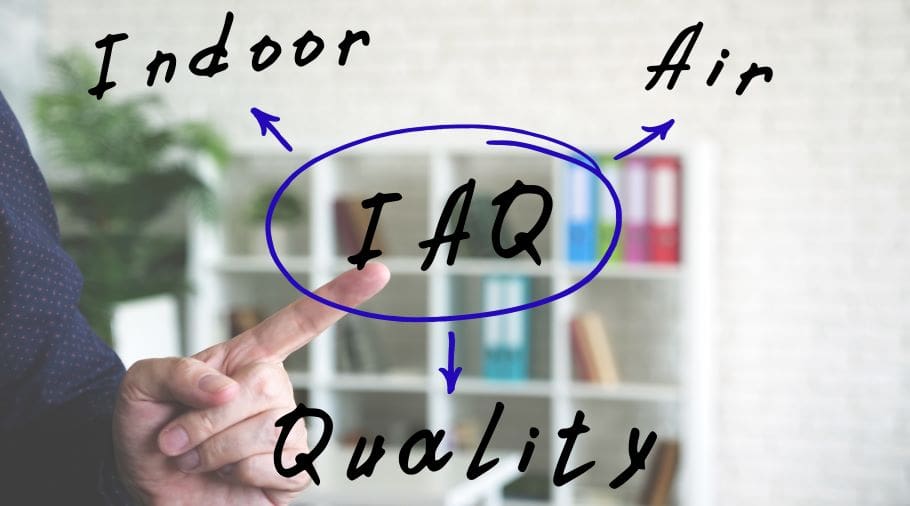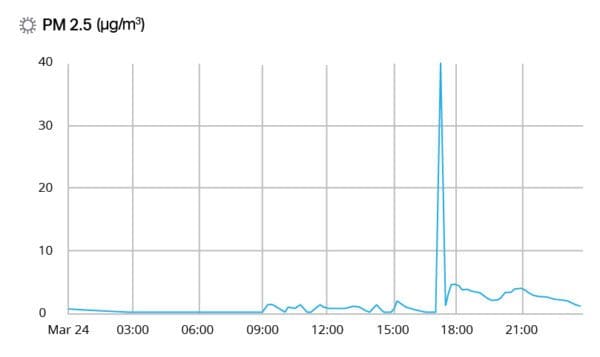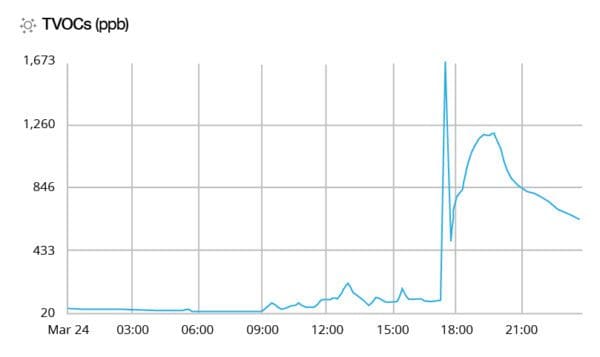Floor Maintenance and IAQ

It is commonly known that poor indoor air quality (IAQ) can have adverse effects on our health, but did you also know that how we maintain our hard floors can also impact the air we breathe? As a nation, we spend more than 90% of our time indoors, so it should not come as a surprise that indoor air pollution is one of the top environmental risks to public health.
Polluted indoor air can cause symptoms such as headaches, dizziness, and reduced lung function. One of the key contributors to poor IAQ involves the maintenance of hard floor surfaces.
Adopting a floor care plan that drastically reduces common pollutants can help improve your IAQ significantly and ensure a healthy indoor environment.
CLEANING, DISINFECTING, AND SANITIZING
Dust, mold, pathogens, and volatile organic compounds (VOCs) from floor chemicals reduce indoor air quality (IAQ). Harsh disinfectants and cleaners release especially high amounts of VOCs.
Interestingly, manufacturers often add fragrances, like limonene, a terpene, to “green products” to create a pleasant scent. These fragrances contain some of the highest VOC concentrations. Professor Anne Steinemann, a civil engineer in Melbourne, Australia, tested 13 “green” products and found limonene in 11 of them.
Long-term, repeated exposure to these fragrances can cause serious respiratory issues for facility employees.
You can safeguard IAQ indoors while cleaning by adopting the following practices:
- Choose cleaners, disinfectants, and sanitizers that meet the US EPA’s “Safer Choice” standard. Read safety data sheets carefully, and scan for harmful chemicals like limonene, ethanol, pinenes, and acetaldehyde.
- Open windows or use exhaust fans while cleaning to ventilate the space and reduce strong smells.
- If your budget allows, invest in a high-quality air purification system with HEPA filters.
- Use only the amount of product you need, and rinse surfaces thoroughly with water to remove leftover substances.
- When dusting floors, switch to commercial hard-floor vacuum cleaners with HEPA filters. These outperform dust mops by trapping contaminants instead of releasing them back into the air.
-
Stop using string mops and mop buckets. These tools leave moisture behind and fail to clean surfaces well, creating ideal conditions for bacteria, viruses, and mold. Instead, use automatic floor scrubbers when possible. These machines dispense cleaner, scrub the floor, and leave it dry, saving time and improving hygiene. Make sure they include easy-to-clean tanks so you always use fresh water.
- If you can’t afford auto scrubbers or vacuum cleaners, use clean microfiber cloths to mop and dust floors during both wet and dry cleaning.
MAINTAINING FINISHED FLOORS
When you buff, strip, and refinish wax floors, you may unintentionally expose yourself to a range of toxic airborne pollutants. These include chemical strippers, toxins in acrylic wax finishes, and pathogens released during buffing. Each step in the process harms indoor air quality and poses health risks to building occupants.
BUFFING
Whether or not floors have wax coatings, buffing them releases large amounts of dust, mold, and pathogens into the air, contributing to unhealthy indoor air quality (IAQ). Buffing generates air pollution that includes large particles (PM10), which can stay airborne for minutes or hours, and fine inhalable particles (PM2.5), which can linger for days or even weeks.
These particles pose an even larger threat because they can host disease-causing microbes. This danger is outlined in a report from the CDC (Center for Disease Control) (2019):
A variety of airborne infections in susceptible hosts can result from exposures to clinically significant microorganisms released into the air when environmental reservoirs (i.e., soil, water, dust, and decaying organic matter) are disturbed. Once these materials are brought indoors into a healthcare facility by any number of vehicles (e.g., people, air currents, water, construction materials, and equipment), the attendant microorganisms can proliferate in various indoor ecological niches and, if subsequently disbursed into the air, serve as a source for airborne healthcare-associated infections. (Guidelines for Environmental Infection Control in Healthcare Facilities, p. 20).
Although foot traffic introduces substantial amounts of dust, dirt, and other contaminants to the indoor environment, IAQ is especially threatened when floors are buffed. An experiment that illustrates this issue was conducted at St. Michael-Albertville High School in Minnesota.
THE TEST
An Awair Omni air quality meter was used to record levels of PM2.5 and VOCs in a high-traffic corridor during an entire day, including when halls were empty, while students were milling through the halls during passing time, and when floors were buffed in the evening.
The readings showed a steep spike in fine particulate matter (PM2.5) and VOCs during floor buffing, while levels stayed low throughout the school day (see Figures 1 and 2). You might assume foot traffic alone stirs up high PM2.5 levels, but measurements revealed much lower pollution during those times compared to buffing. This proves that buffing floors produces alarmingly unhealthy indoor air quality and requires immediate attention.

Figure 1. The number of fine particulates (PM2.5) spikes dramatically when floors are buffed.

Figure 2. The number of VOCs (Volatile Organic Compounds) shows a dramatic spike when floors are buffed. Levels remain elevated post-buffing, as well.
STRIPPING AND REFINISHING WAX FLOORS
When you use an acrylic wax floor coating program, foot traffic, debris, furniture, and machinery quickly wear off the floor wax and dull the surface. To keep floors looking good, you must scrub and rewax them every 3-6 months and strip (completely remove) the wax every 1-3 years. Stripping floors creates a toxic slurry made of chemical stripper and water. You need to let it sit for 10 to 15 minutes before
removing it.
Chemical solvents in the stripper break down and emulsify the old wax layers. This process produces a toxic mix of acrylic wax and wax stripper chemicals, including formaldehyde, nitrobenzene, perchloroethylene, phenol, toluene, xylene, and VOC-laden solvents like monoethanolamine. Breathing in these vapors can cause headaches, eye irritation, respiratory distress, and other health problems.
To protect building occupants, you must ventilate properly and allow enough time for the products to dry and fumes to clear before reoccupying the space. Some lower-VOC wax strippers exist, but many people find them less effective than traditional formulas. Using “green” strippers often requires applying more product and extra labor.
Refinishing waxed floors involves scrubbing with water to remove the top wax layers, then applying new layers. This process also releases VOCs as the wax dries. So, you must provide adequate ventilation during both application and drying—imagine repeating this every 3 months!
THE BEST ALTERNATIVE TO THE USE OF FLOOR WAX
Can you maintain great-looking floors while preserving indoor air quality? Definitely!
Some people find it challenging to switch from wax to a new floor care regimen. However, one product dramatically reduces IAQ threats and keeps building occupants healthier.
A groundbreaking thin-film, water-based urethane has entered the floorcare industry. It provides a solution to the environmental hazards caused by traditional floor maintenance.
Unlike wax, EPIC® High-Performance Floor Finish requires
no buffing and lasts 3-5 years with just one coat, even in high-traffic areas. The finish forms a strong barrier that resists abrasion, chemical damage, and rapid dulling. Over 10 years, you only need 2 or 3 recoats of EPIC, compared to 20-30 recoats of acrylic wax.
Moreover, EPIC does not need to be stripped again once all wax is completely removed prior to application. Therefore, compared to an acrylic wax floorcare program, EPIC significantly reduces the introduction of nasty odors, VOCs, particulates, and pathogens into the air.
Because the EPIC floorcare system produces fewer emissions, your facility can earn LEED points and credit toward other green facility certifications. Most importantly, improved IAQ promotes employee health, productivity, accessibility, and overall safety. Remember, you don’t have to compromise indoor air quality (IAQ) when maintaining floors.
Get a FREE SUSTAINABILITY ROI REPORT comparing these two floorcare programs.
EPIC® High-Performance Floor Finish
Ultra Durable Technologies has developed EPIC®, a water-based thin-film urethane coating for VCT (Vinyl Composite Tile), tile and grout, LVT/LVP (luxury vinyl products), linoleum, terrazzo, and concrete. Transform your facility with EPIC!
Sources
Steinemann, Anne, et al. “Pandemic Products and Volatile Chemical Emissions.” Air Quality, Atmosphere & Health, vol. 14, no. 1, 2020, pp. 47–53., https://doi.org/10.1007/s11869-020-00912-9.
“Cleaning Products & Indoor Air Quality.” California Air Resources Board, https://ww2.arb.ca.gov/resources/fact-sheets/cleaning-products-indoor-air-quality
“Guidelines for Environmental Infection Control in Healthcare Facilities.” Centers for Disease Control and Prevention, 23 July 2019, https://www.cdc.gov/infectioncontrol/guidelines/environmental/index.html.
“Volatile Organic Compounds' Impact on Indoor Air Quality.” EPA (Environmental Protection Agency), https://www.cdc.gov/infection-control/hcp/environmental-control/index.html.
